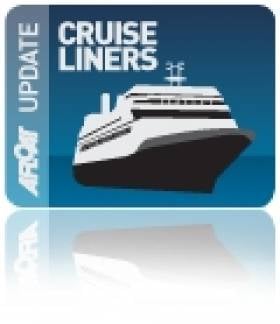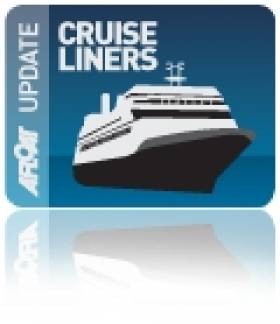Displaying items by tag: Royal Caribbean International
A First for Cobh as Two Cruise Giants Come and Go
In an unprecedented scheduling of cruiseships to the Port of Cork (Cobh), the inbound Independence of the Seas (154,407 tonnes) the largest cruiseship to call to any Irish port, passed the 122,000 tonnes Celebrity Eclipse which was preparing to depart from the town's cruise terminal.
Some 15 minutes later Celebrity Eclipse pulled away from the berth. During that timeframe the Independence of the Seas had completely turned around in the opposite direction to face Cobh after maneuvering in the swinging basin between Cobh and the Naval Base on Haulbowline Island.
The 4,175-passenger Independence of the Seas is the third of the 'Freedom' class vessels. She has a length of 339m and is a mere 11m shorter in distance to that of the 350m berth at Cobh. The 38m wide cruiseship has a draft of 8.7m and the depth of water at the town's quayside is 9.1m.
The 15-deck vessel was built by Aker Finnyards in Turku, Finland in 2008 for Royal Caribbean International (RCI). Amenities on the Freedom class consist of the an innovative surf park, canitilevered whirlpools, ice-skating rink, full-size boxing ring and a H2O Zone waterpark.
As for the 3,179-passenger Celebrity Eclipse, she is the second of five 'Solstice' class sisters and measures 317m (length) 48m (beam) and draws 8.6m. On the top deck there is the fresh green grass located at Lawn Club. She was built by the Meyer Werft shipyard in Papenburg, Germany and entered service last year for her owners Celebrity Cruises.
Independence of the Seas departed yesterday afternoon on an overnight passage from Southampton where the vessel is based in the summer and for the winter she is based out of Florida. The Celebrity Eclipse departed the UK south coast port from Cobh where the larger cruiseship is also to make overnight port of call.
In total 10,000 passengers and crew will of visited the Cork Harbour region alone over the May Bank holiday. To meet the surge in demand for the shore-based excusions a fleet of buses awaited and additional trains were also laid-on by Irish Rail. The railway station is located next-door to the Cobh Heritage Centre which retraces the town's strong trans-Atlantic liner era.
- Cobh
- Cork Harbour
- port of Cork
- Independence of the Seas
- Ports and Shipping
- Cobh Cruise Terminal
- Ports and Shipping News
- Cork Harbour News
- Irish Rail
- Celebrity Eclipse
- Port of Cork News
- Aker Finnyards
- Celebrity Cruises
- Royal Caribbean International
- Freedomclass
- Solsticeclass
- MeyerWerft
- Cobh Heritage Centre
Cruise Giants to Meet off Cobh
For the first time two cruiseship giants are scheduled to depart and arrive off Cobh at the same time this May Bank Holiday weekend, writes Jehan Ashmore.
The largest cruiseship to call to an Irish port the Independence of the Sea which weighs 154,407 gross tonnes (some 6,000 tonnes larger than the liner Queen Mary 2) will pass the Cobh-berthed Celebrity Eclipse of 122,000 tonnes around 14.00hrs on Sunday.
Weather permitting the Independence of the Seas will then be maneuvering in the swinging basin between Haulbowline and Cobh, just upriver of the Celebrity Eclipse which will then begin to pull away from the deepwater berth at the Cobh Cruise Terminal.
The 350m long berth has a quayside depth of 9m and is capable of handling some of the largest cruiseships on this island.
Prior to Sunday's sailing spectacle the Celebrity Eclipse is due to dock tomorrow afternoon for the overnight call. Likewise the 4,375 passenger Independence of the Seas will stay at Cobh for an overnight call and then depart's on Monday evening.
“Two such large cruise liners, have never before been in Cork Harbour at the same time, let alone pass each other creating a magnificent sight. An excellent viewing point for anyone planning on visiting Cobh on Sunday 1st May would be the High Road or Whitepoint in Cobh” said Port of Cork Commercial Manager, Captain Micheal McCarthy.
Together the cruiseships will have a combined gross tonnage of nearly 300,000 tonnes and they will bring 10,000 passengers and crew into the Cork region this weekend alone. Celebrity Eclipse is operated by Celebrity Cruises and the Independence of the Seas is run by Royal Caribbean International.
The 3,129 passenger Celebrity Eclipse made her 'maiden' cruise and port of call to Cobh last year following her high profile repatriation voyage from Spain with stranded UK tourists arising from the fallout of the Icelandic volcanic ash-cloud.
On that inaugural ocasion the Celebrity Eclipse which cost €500m became the 500th cruise caller to the Port of Cork where the vessel made an overnight call at Cobh. To see a time-lapse video marking the 500th cruiseship's arrival click here.






























































